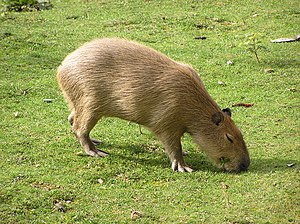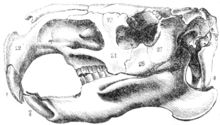호저아목
(바늘두더지아목에서 넘어옴)
호저아목 또는 바늘두더지아목(Hystricomorpha)은 역사적으로 다양한 정의가 있다. 넓은 의미에서는 천축서형의 협골궁형 교근을 지닌 뛰는쥐과를 제외한 대부분의 설치류를 가리킨다. 이 아목은 산미치광이하목과 군디과, 비늘꼬리청서과 그리고 뜀토끼과를 포함하고 있다. 분자생물학과 형태학적 연구 결과는 호저아목 내에 비늘꼬리청서과와 뜀토끼과를 포함시키는 것에 의문을 제기하고 있다. 2005년 칼레톤(Carleton)과 무세르(Musser)는 이 2개 과를 별도의 아목인 비늘꼬리청서아목으로 분류하여 취급하고 있다.
|
| ||
|---|---|---|
 카피바라 | ||
| 생물 분류ℹ️ | ||
| 계: | 동물계 | |
| 문: | 척삭동물문 | |
| 강: | 포유강 | |
| 목: | 쥐목 | |
| 아목: | 호저아목 (Hystricomorpha) Brandt, 1855 | |
| 과 | ||
| ||

하위 분류
편집계통 분류
편집다음은 쥐목의 계통 분류이다.[1]
| 쥐목 |
| ||||||||||||||||||||||||||||||||||||||||||||||||||||||
다음은 호저아목의 계통 분류이다.[2]
| 호저아목 |
| |||||||||||||||||||||||||||||||||||||||||||||||||||||||||||||||||||||||||||||||||||||||||||||||||||
각주
편집- ↑ Heritage S. et al. 2016. Ancient phylogenetic divergence of the enigmatic African rodent Zenkerella and the origin of anomalurid gliding. PeerJ 4: e2320; doi: 10.7717/peerj.2320
- ↑ Pierre-Henri Fabre, Lionel Hautier, Dimitar Dimitrov, Emmanuel J P Douzery (2012): A glimpse on the pattern of rodent diversification: a phylogenetic approach. BMC Evolutionary Biology 2012, 12: 88 (online open access)
- Bergsten, J. 2005. A review of long-branch attraction. Cladistics, 21:163-193.
- Cao, Y., Adachi, J., Yano, T. and Hasegawa, M. 1994. Phylogenetic place of guinea pigs: No support of the rodent-polyphyly hypothesis from maximum-likelihood analyses of multiple protein sequences. Molecular Biology and Evolution, 11: 593-604.
- Carleton, M. D. and G. G. Musser. 2005. Order Rodentia. Pp745–752 in Mammal Species of the World A Taxonomic and Geographic Reference (D. E. Wilson and D. M. Reeder eds.). Baltimore, Johns Hopkins University Press.
- D'Erchia, A., Gissi, C., Pesole, G., Saccone, C. and Arnason, U. 1996. The guinea-pig is not a rodent. Nature, 381 (6583): 597-600.
- Flynn, J. J., Wyss, A. R., Croft, D. A., and Charrier, R. 2003. The Tinguiririca Fauna, Chile: biochronology, paleoecology, biogeography, and a new earliest Oligocene South American Land Mammal ‘Age’. Palaeogeography, Palaeoclimatology, Palaeoecology, 195:229-259.
- Graur, D., Hide, W. and Li, W. 1991. Is the guinea-pig a rodent? Nature, 351: 649-652.
- Huchon, D. E. J. P. Douzery. 2001. From the Old World to the New World: A molecular chronicle of the phylogeny and biogeography of hystricognath rodents. Molecular Phylogenetics and Evolution, 20:238-251.
- Kuma, K. and Miyata, T. 1994. Mammalian phylogeny inferred from multiple protein data. Japanese Journal of Genetics, 69 (5): 555-66.
- Landry, S. O. J. 1999. A proposal for a new classification and nomenclature for the glires. Mitt. Mus. Nat. Kd. Berl. Zool. Reihe, 75:283-316.
- Lin, Y-H, et al. 2002. Four new mitochondrial genomes and the increased stability of evolutionary trees of mammals from improved taxon sampling. Molecular Biology and Evolution, 19: 2060-2070.
- Marivaux, L., M. Vianey-Liaud, and J.-J. Jaeger. 2004. High-level phylogeny of early Tertiary rodents: dental evidence. Zoological Journal of the Linnean Society, 142:105-134.
- Marivaux, L. J. L. Welcomme, M. Vianey-Liaud, and J.J. Jaeger. 2002. The role of Asia in the origin and diversification of hystricognathous rodents. Zoologica Scripta, 31:225-239.
- McKenna, Malcolm C., and Bell, Susan K. 1997. Classification of Mammals Above the Species Level. Columbia University Press, New York, 631 pp. ISBN 0-231-11013-8
- Reyes, A., Pesole, G. and Saccone, C. 2000. Long-branch attraction phenomenon and the impact of among-site rate variation on rodent phylogeny. Gene, 259 (1-2): 177-87.
- Reyes, A., Gissi, C., Catzeflis, F., Nevo, E. Pesole, G. and Saccone, C. 2004. Congruent mammalian trees from mitochondrial and nuclear genes using Bayesian methods. Molecular Biology and Evolution, 21 (2): 397-403.
- Robinson-Rechavi, M., Ponger, L. and Mouchiroud, D. 2000. Nuclear gene LCAT supports rodent monophyly. Molecular Biology and Evolution, 17: 1410-1412.
- Sullivan, J. and Swofford, D.L. 1997. Are guinea pigs rodents? the importance of adequate models in molecular phylogenetics. Journal of Mammalian Evolution, 4: 77-86.